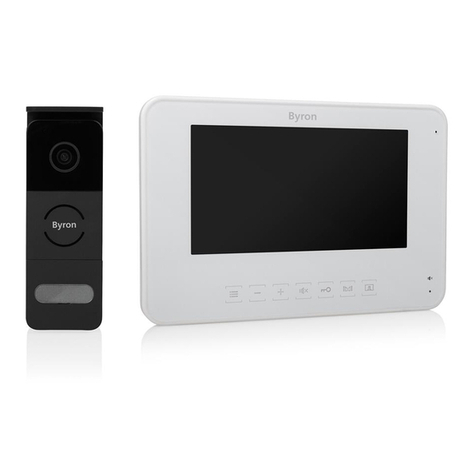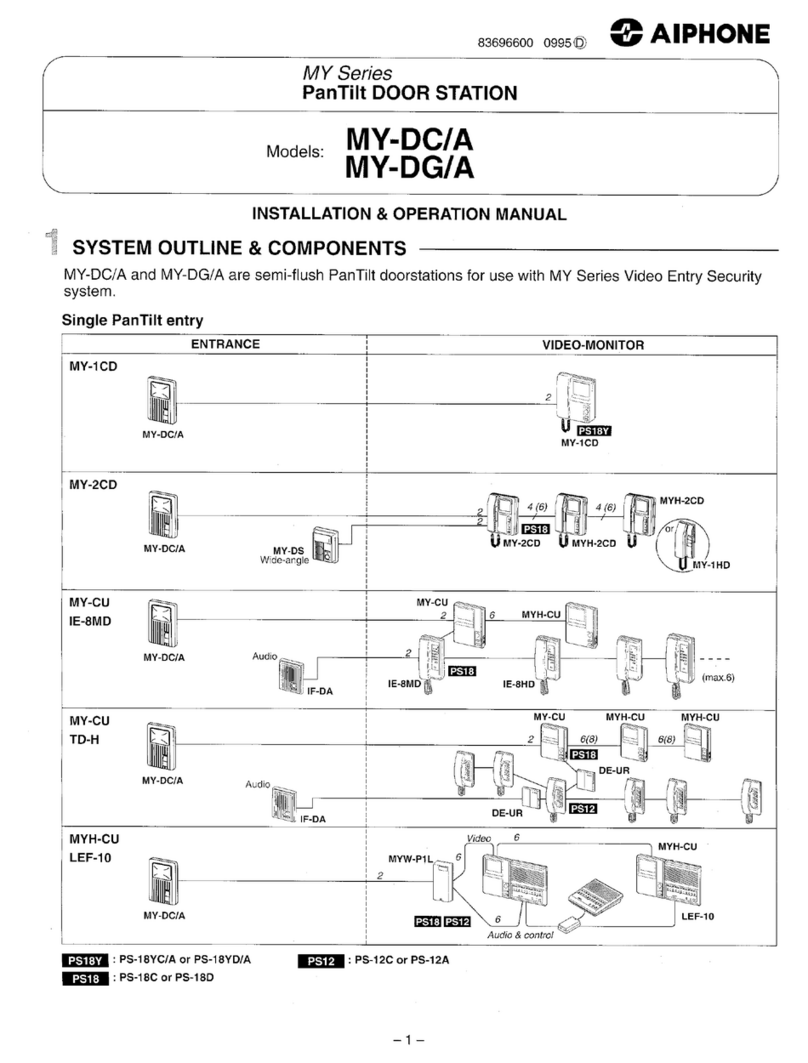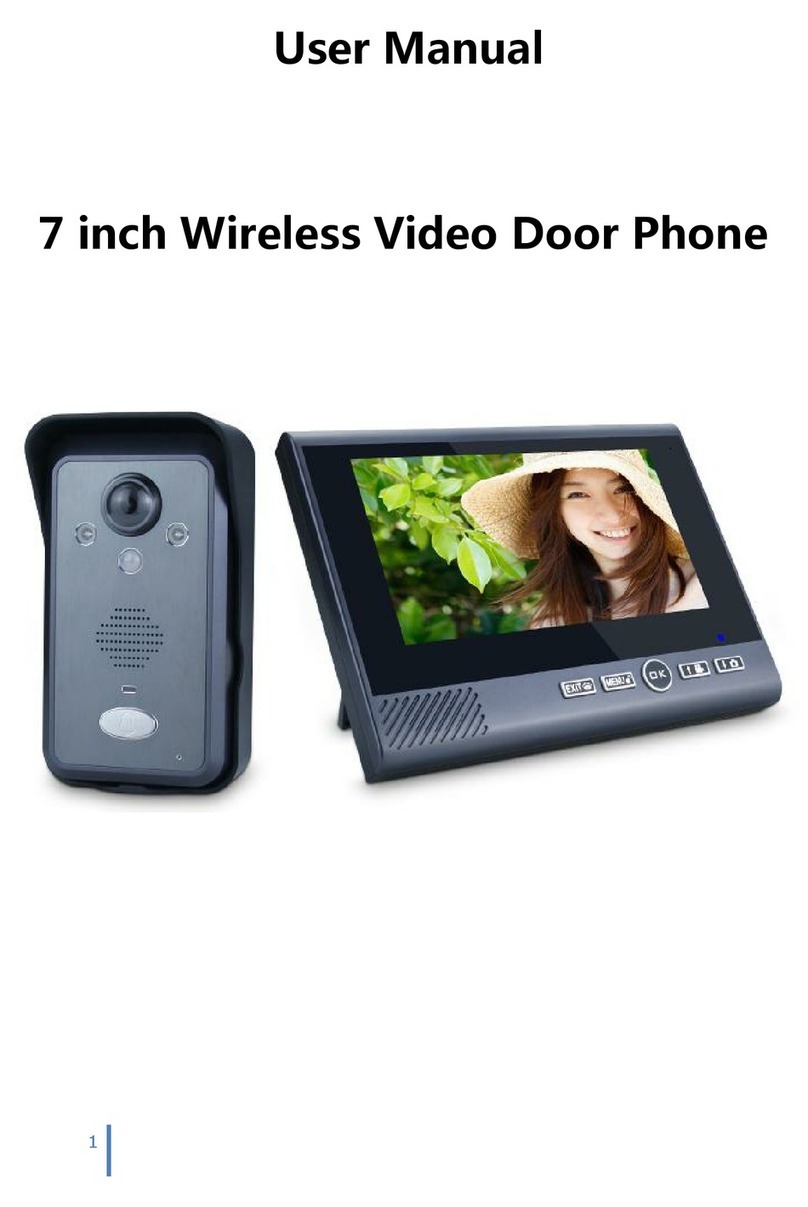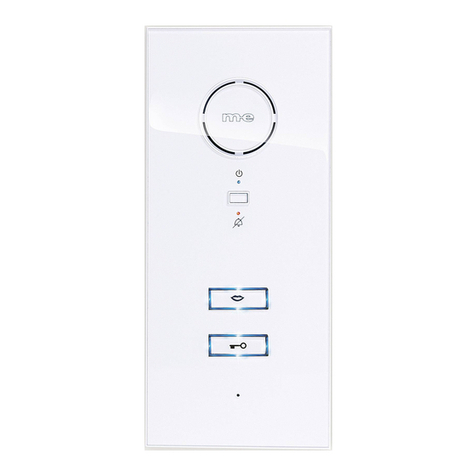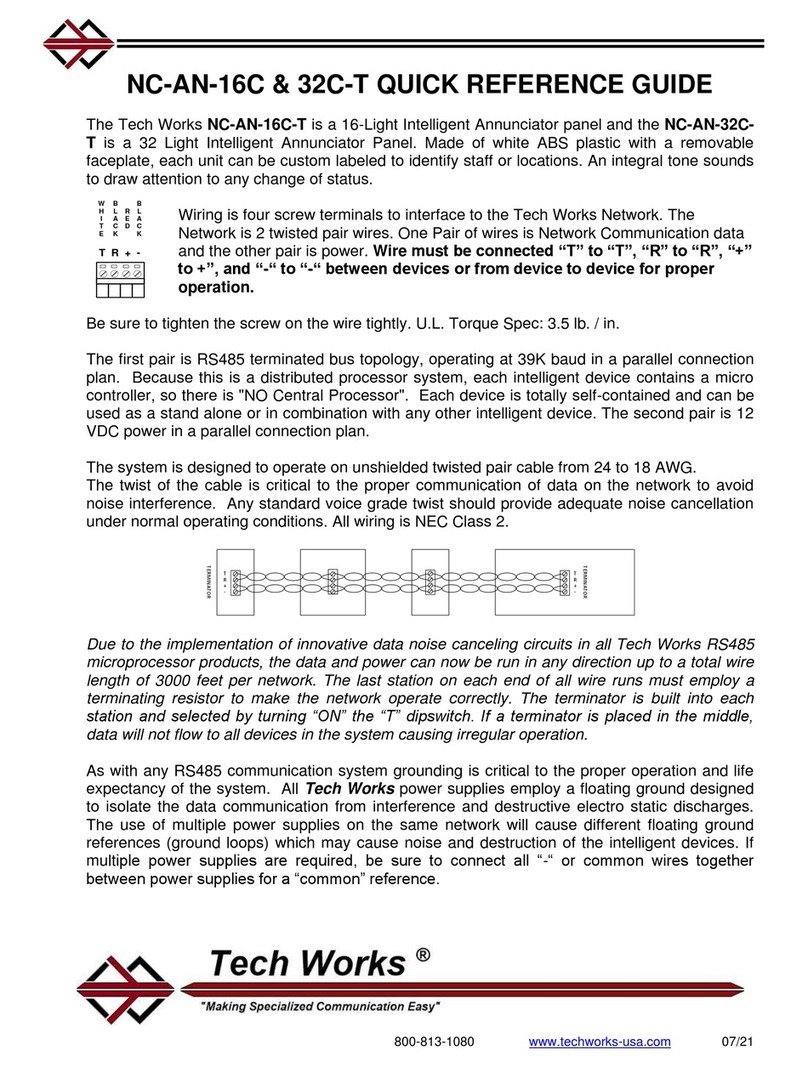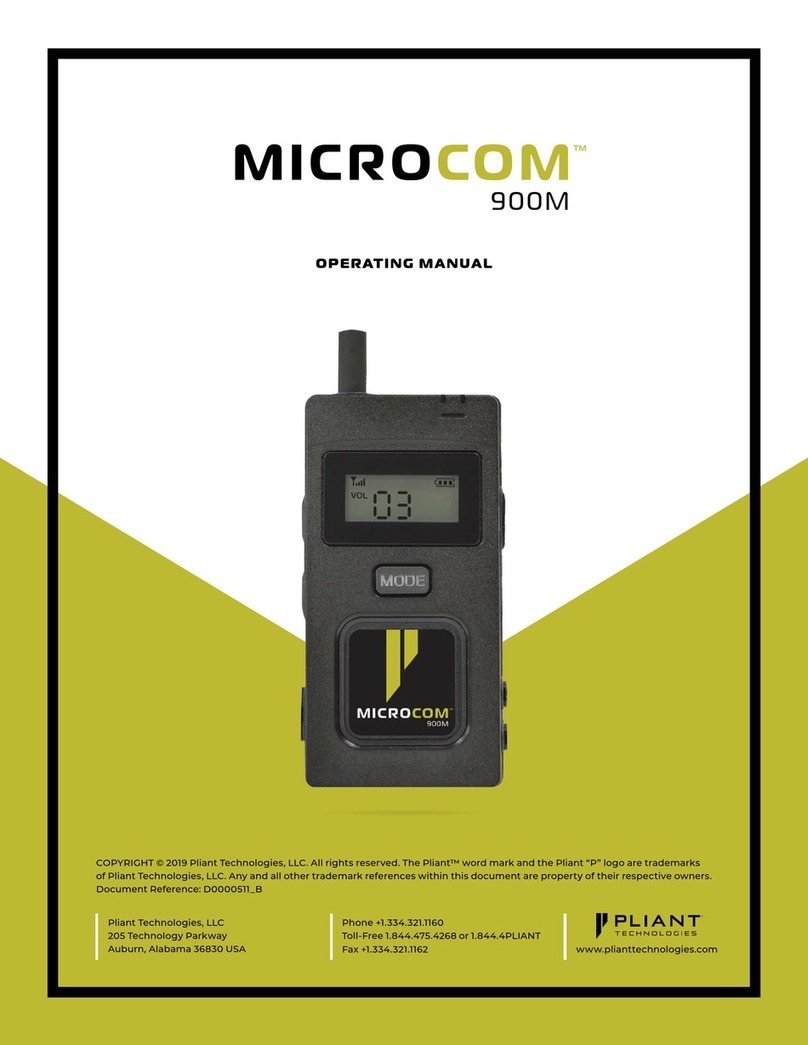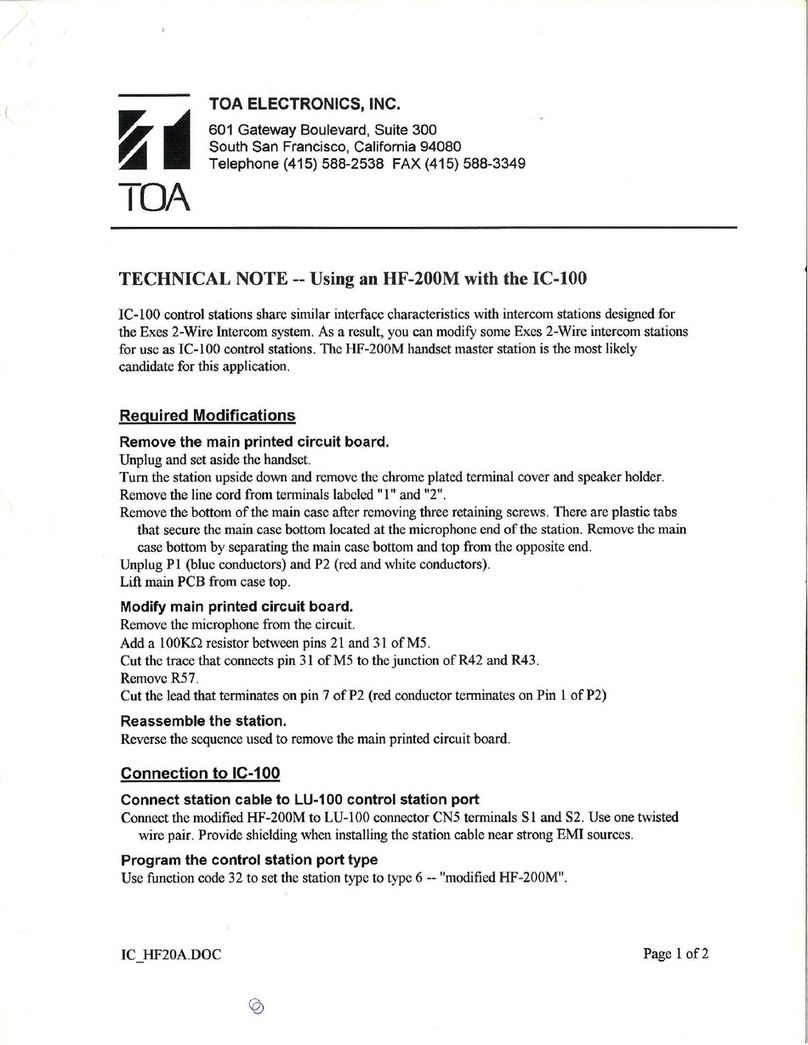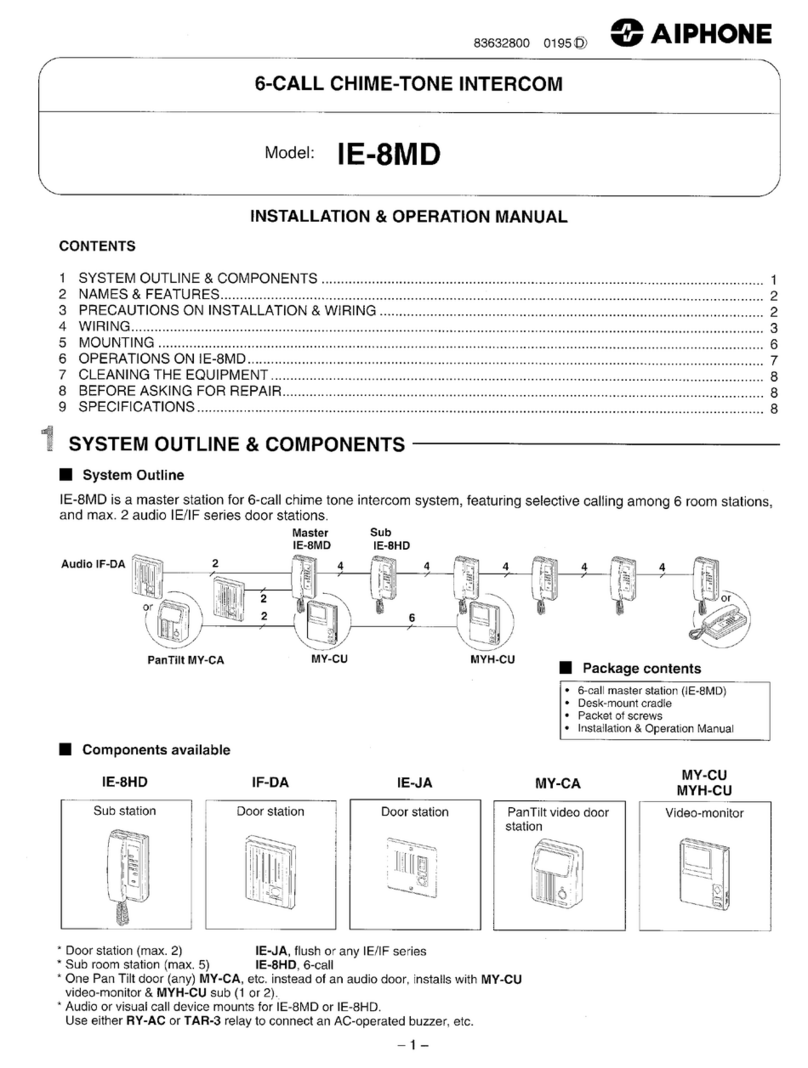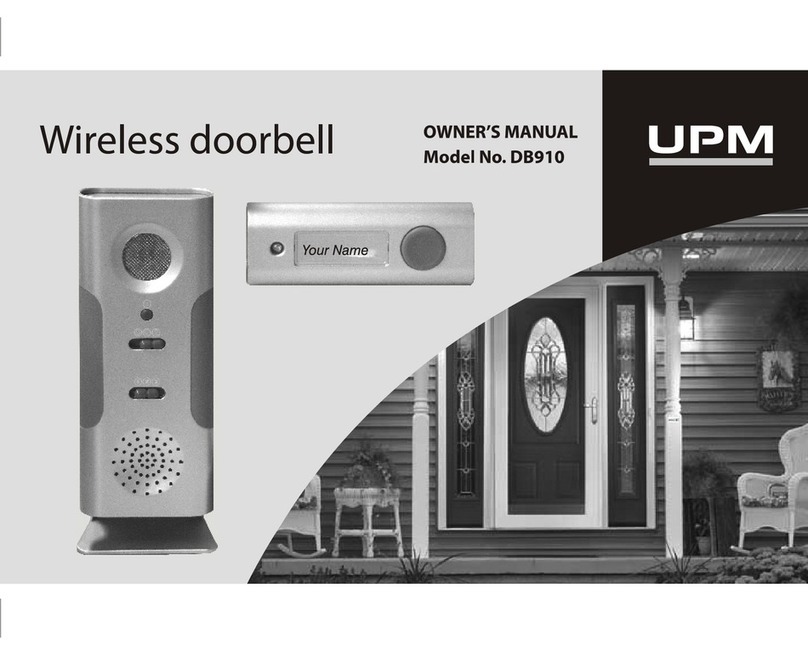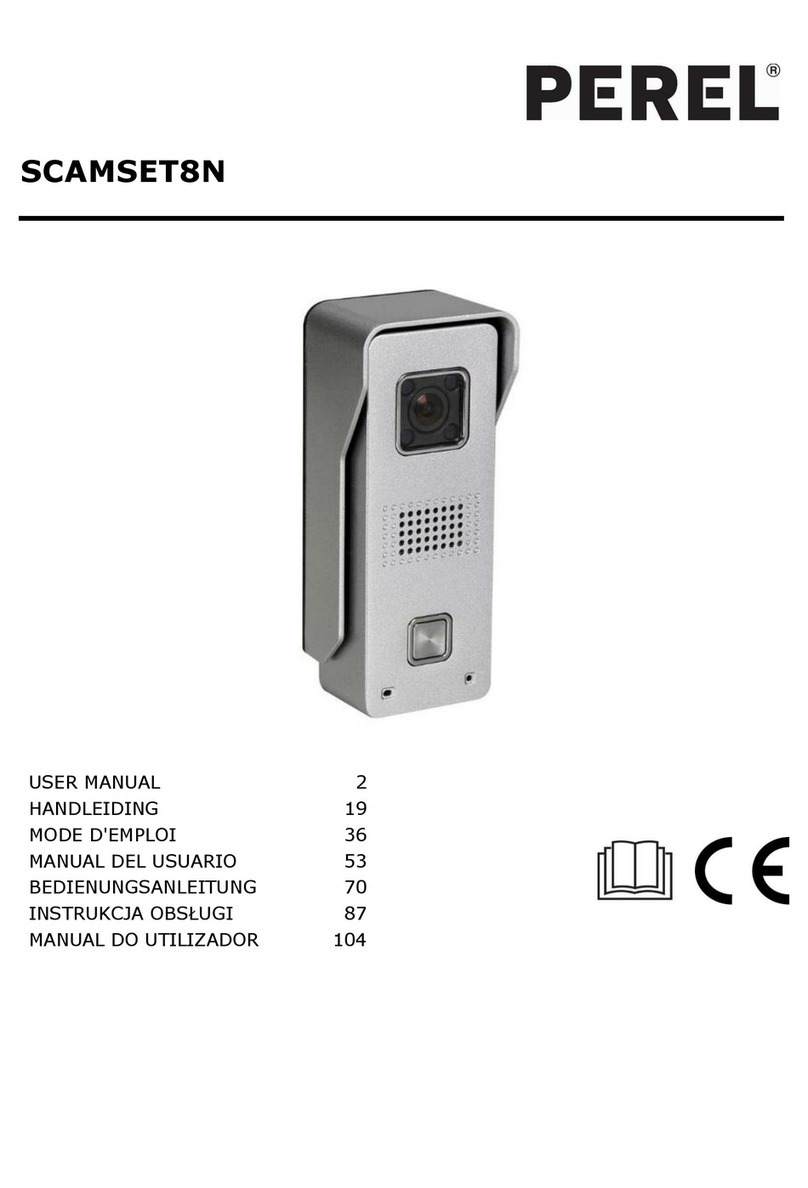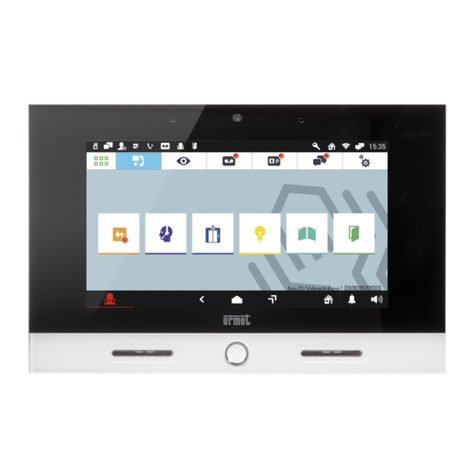SKS-Kinkel HT 4600 User manual

~ 1 ~
HT 4600
Version 1.1

~ 2 ~
1. Installation
Gefahr für Personen durch einen elektrischen Schlag. Verbrennungsgefahr, Geräteschäden und
Fehlfunktionen. Bei der Installation sind die Richtlinien der VDE 0100 und VDE 0800 einzuhalten.
(Deutschland)
Gegenmaßnahmen:
Schalten Sie zu Beginn der Arbeiten alle Spannungsführenden Leitungen frei.
Sichern Sie die ausgeschalteten Leitungen gegen irrtümliches Wiedereinschalten.
Stellen Sie Spannungsfreiheit durch Messung fest.
Decken Sie benachbarte, unter Spannung stehende, oder leitfähige Teile ab.
Alle Arbeiten und elektrische Anschlüsse müssen den nationalen Bestimmungen des jeweiligen
Landes entsprechen und von entsprechend ausgebildetem Fachpersonal durchgeführt werden.
Bei Geräten mit 230-V-Anschluss ist die DIN VDE 0100 zu beachten und einzuhalten.
2. Klemmenbezeichnung
Klemme
Bezeichnung
a
BUS-Klemme
b
BUS-Klemme
E+
Etagenklingel
E-
Etagenklingel
P
Potenzialfreier Kontakt (nur Sondermodelle)

~ 3 ~
3. Montageanleitung HT4600
Mit einem Schraubenzieher vorsichtig den unteren
Klipp eindrücken und die Front abnehmen.
Aufputz Montage:
Mit Dübel und Schrauben das Hinterteil der Sprech-
stelle an der Wand befestigen. Dabei auf das Kabel
achten!
Unterputz Montage:
Mit zwei Schrauben das Hinterteil der Sprechstelle an
der Unterputzdose befestigen. Dabei auf das Kabel
achten!

~ 4 ~
Montageanleitung HT4600 (Fortsetzung)
Verbinden Sie das Kabel mit der Anschlussklemme.
Stellen Sie die SKS-BUS Rufadresse an der
Sprechstelle ein. Jede Adresse ist einem Klingel
Taster an der Türstation zugeordnet. Die Adressen
sind im Anhang aufgeführt. In der Regel wird mit der
SKS-BUS Rufadresse „A1“ begonnen.
Beim Austausch von Sprechstellen stellen Sie den
DIP-Schalter so ein wie bei der zuvor montierten
Sprechstelle.
Das Frontteil auf das Hinterteil drücken, bis die Klipps
einrasten. Achten Sie dabei darauf, dass keine
blanken Adern die Leiterplatte von hinten berühren
können.

~ 5 ~
4. Programmierung
4.1 Programmierung von nur einer Rufadresse (ein Klingeltaster für eine Sprechstelle)
Nach der im Anhang befindlichen SKS-BUS Rufadressen Tabelle die gewünschte Rufadresse des
Gerätes am DIP-Schalter einstellen. Jede Rufadresse ist fest einem Klingeltaster in der Türstation
zugeordnet. Die Rufadressenverteilung ist bei SKS Türstationen in der Türstation oder am
Türlautsprecher 4503, 4508 oder 4808 hinterlegt.
4.2 Programmierung von bis zu 4 Rufadressen
(2...4 Klingeltaster für eine Sprechstelle oder Internsprechen)
Die Sprechstelle kann bis zu 4 SKS-BUS Rufadressen für Hausruf-, Internrufadressen oder
Gruppenrufadressen speichern. Die erste Adresse ist dann die Hauptadresse, die als eigene
Gerätekennung übermittelt wird. Auf die bis zu 3 weiteren Rufadressen reagiert die Sprechstelle bei
eingehenden Hausrufen (Klingeltasten der Türstation), Internrufen (Sprechen zwischen zwei
Innensprechstellen) und Gruppenruf (Sprechen von einer Innensprechstelle mit einer von bis zu 4
Innensprechstellen).
Arbeitsschritt
Beschreibung
1
Die Rufadresse am DIP-Schalter einstellen. Die 1. Rufadresse ist der Hausruf
(Klingeltaste an der Türstation).
2
Die Programmiertaste für ca. 5 Sekunden drücken bis der erste Kontrollton
ertönt.
3
Nach diesem Kontrollton ertönt ein kurzer Ton. Er signalisiert, dass die erste
Rufadresse programmiert ist.
Die Anzahl der kurzen Töne signalisieren auf welchem Speicherplatz die
Rufadresse gespeichert wurde.
4
Zum Programmieren weiterer Rufadressen wieder holen Sie die Schritte 1 bis 3.
Es können maximal 4 Rufadressen gespeichert werden. Sollen Rufadressen
geändert werden, müssen zuvor wie unter 4.3 beschrieben, alle Rufadressen
gelöscht werden.
Hinweis:
Nach Abschluss der Programmierung den DIP-Schalter wieder auf die Hauptadresse einstellen,
damit eine leichtere Zuordnung der Klingeltaste zur Sprechstelle im Fehlerfall möglich ist.
4.3 Löschen aller Rufadressen
Es können keine einzelnen Rufadressen gelöscht werden. Es werden immer alle Rufadressen
gelöscht. Halten Sie die Programmtaste für ca. 25 Sekunden gedrückt. Während dessen sind mehrere
Kontrolltöne zu hören. Die Löschung ist abgeschlossen, wenn ein 3 Sekunden langer hoher Signalton
ertönt. Lassen Sie jetzt die Programmtaste los. Alle Rufadressen sind jetzt gelöscht.
Hinweis:
Nach dem Löschen der Einprogrammierten Rufadressen ist nur die Adresse, welche am DIP-
Schalter eingestellt ist wirksam wie unter 4.1 beschrieben.
Nur für
Sonderfunktionen

~ 6 ~
5. Einrichten des Internrufs
5.1 Programmieren der Internrufadressen
Internsprechen ermöglicht das Sprechen zwischen zwei Innensprechstellen. Mit der HT4600 kann mit
bis zu 6 Innensprechstellen gesprochen werden. An der HT4600 sind dafür die Tasten 1 bis 6
vorgesehen. Durch Drücken der entsprechenden Taste wird der Internruf abgesetzt.
Intersprechstelle
Internsprechtaste(n)
A
1
B
2
C
3
D
4
E
5
F
6
Ablauf der Programmierung für Internrufadressen:
Hinweis:
Bevor Interrufadressen programmiert werden können, muss die Hausrufadresse wie unter 4.2
beschrieben programmiert sein.
Arbeitsschritt
Beschreibung
1
Die Internrufadresse (Zieladresse) am DIP-Schalter einstellen.
2
Halten Sie die Programmiertaste gedrückt und drücken Sie innerhalb von 2
Sekunden die gewünschte Internsprechtaste für die gewünschte
Innensprechstelle. Halten Sie die Tastenkombination für ca. 5 Sekunden
gedrückt bis Sie den zweiten SIgnalton hören.
5.2 Löschen von Internrufadressen
Es können keine einzelnen Internrufadressen gelöscht werden. Beim Löschen werden immer alle
abgelegten Internrufadressen gelöscht.
Halten Sie die Programmtaste gedrückt und betätigen Sie innerhalb von 2 Sekunden die entsprechende
Internsprechtaste. Die Löschung ist abgeschlossen, wenn ein 3 Sekunden langer hoher Ton ertönt.
Lassen Sie die Tasten los. Alle Rufadressen sind jetzt gelöscht.

~ 7 ~
6. Bedienungsanleitung
Funktion
Tasten
Vorgehensweise
Gespräch annehmen
Nehmen Sie nachdem das Gerät angeklingelt wurde den Hörer ab.
Rufabschaltung
Nehmen Sie den Hörer ab und halten Sie die Tontaste solange
gedrückt (ca. 5 Sekunden), bis Sie die Bestätigungstöne (3
gleichlange Töne) hören. Der Rufton ist jetzt abgeschaltet. Um auf
diesen Zustand hinzuweisen, blinkt die Ton-Bild-Taste im
Sekundentakt.
Der Rufton wird automatisch nach 12 Stunden oder nach
Spannungsausfall wieder eingeschaltet.
Rufeinschaltung
Tippen Sie kurz auf die Tontaste. Sie hören einen durchgehenden
hohen Signalton. Der Rufton ist jetzt wieder eingeschaltet.
Tür öffnen
Wurde das Gerät angeklingelt, kann innerhalb von 2,5 Minuten mit
der Türöffnertaste die Tür geöffnet werden.
Hausrufklingelton
ändern
+
Die Tontaste gedrückt halten und anschließend die Türöffnertaste
innerhalb von 2 Sekunden kurz drücken. Mit jedem Tastendruck der
Türöffnertaste erklingt eine andere Melodie. Wird die gewünschte
Melodie abgespielt, lassen Sie beide Tasten los.
Es stehen 8 verschiedene Kingeltöne zur Auswahl.
Etagenrufklingelton
ändern
+
Die Tontaste gedrückt halten und anschließend die Türöffnertaste
innerhalb von 2 Sekunden drücken und beide gedrückt halten.
Warten Sie bis die gewünschte Melodie ertönt. Lassen Sie beide
Tasten los.
Es stehen 4 verschiedene Etagenruftöne zur Auswahl.
Klingellautstärke
ändern
Die Tontaste gedrückt halten, bis die gewünschte Lautstärke erreicht
ist.
Die Lautstärke ist 5-stufig einstellbar.
Licht- und Sondertaste
+
Die Sondertaste „S“ wird standardmäßig mithilfe eines Schaltaktors
4507 zum Schalten verwendet. Des Weiteren wird durch betätigen
der Lichttaste ein interner potentialfreier Kontakt auf der Sprechstelle
geschlossen.
Die Lichttaste kann optional auch zum Schalten des Schaltaktors
verwendet werden. Bitte bei Bestellung angeben.
Internruf
1 -6
Nur Sprechstellen mit 10 Tasten haben die Funktion Internruf. Es
kann mit max. 6 Innensprechstellen gesprochen werden.
Um den Internruf abzusetzen ist der Hörer abzunehmen und die
entsprechende Taste zu betätigen bis ein Bestätigungston
ausgegeben wird.

~ 8 ~
7. Technische Daten
Elektrische Daten
Spannung a / b
19 –23VDC
Allgemeines
Umgebungstemperatur
-10°C bis +45°C
Feuchtigkeit
20% bis 90% nicht kondensierend
Gehäuse
Kunststoffgehäuse
Abmessungen (Breite x Höhe x Tiefe)
82 x 193 x 33mm

~ 9 ~

~ 10 ~
1. Installation
Hazard of electrical strike and burns to persons, as well as damage of equipment and malfunctions.
Observe VDE 0100 and VDE 0800 guidelines during installation. (Germany)
Countermeasures:
Before beginning any work, deactivate and disconnect all energized electrical wires.
Secure the switched off/ disconnected lines against erreneous reconnection.
Use a measuring device to make sure that the wires are deenergized.
Cover up any adjacent, energized or conducting components.
All work and all electrical connections must comply with the national provisions for the country in
question and must be performed by appropriately trained personnel
DIN VDE 0100 must be observed and complied with in devices with a 230V connection
2. Terminal Designation
Terminal
Designation
a
BUS-terminal
b
BUS-terminal
E+
Floor bell
E-
Floor bell
P
Potential-free contact (only on special model)

~ 11 ~
3. Assembly Instructions HT4600
Using a screwdriver, carefully press in the lower
middle clip and remove the front.
Assembly of Mounting Box:
Fasten the rear part of the intercom unit to the wall
using dowels and screws. Watch the cable!
Flush Mounting Socket Assembly:
Using two screws, fasten the rear part of the intercom
to the flush-mounting socket. Watch the cable!

~ 12 ~
Assembly Instructions HT4600 (Continued)
Connect the cable to the terminal connector.
Set the SKS-BUS call address on the intercom. Each
address is assigned to one call button at the door
station. The addresses are listed in the appendix. As a
rule, the SKS-BUS call address set in with “A1“.
When replacing intercom units, set the DIP-Switch as
it is for the previously mounted intercom unit.
Press the front part down onto the rear part until the
clips snap into place. Make sure that no exposed
wires can touch the printed circuit board from behind.

~ 13 ~
4. Programming
4.1 Programming Only One Call Address (One Call button for One Intercom Unit)
Set the desired call address for the device on the DIP-Switch following the SKS-BUS Address Table in
the appendix. Each call address is assigned to one call button in the door station. The call address
distribution is stored in the door station or in the door speaker 4503, 4508 or 4808.
4.2 Programming up to 4 Call Addresses
(2...4 Call buttons for an Intercom Unit or Internal Call Units)
The intercom unit can store up to 4 SKS-BUS call addresses for house call, internal call or group call
addresses. The first address is the main address and is transmitted as the device identification. The
intercom unit will respond to up to 3 additional call addresses for incoming house calls (call button for
the door station), internal calls (talking between two intercom units) and group calls (talking between
one intercom unit and up to 4 other intercom units).
Step
Description
1
Set the call address on the DIP-Switch. The 1st call address is the house call
(call button on the door station).
2
Push the programming button for about 5 seconds until you hear the control
tone.
3
After this control tone sounds you will hear a short tone that signals that the
first call address has been programmed. The number of short tones indicates
the memory location at which the call address was stored.
4
To program additional call addresses, repeat steps 1 to 3. A maximum of 4 call
addresses can be stored. If call addresses need to be changed, all call
addresses must first be deleted, as described under 4.3.
Note:
After programming is finished, set the DIP-Switch to the main address again so that it is possible
to assign the button to the intercom in the case of a fault.
4.3 Delete All Call Addresses
Call addresses cannot be deleted individually. All addresses are deleted every time. Hold the
programming button down for around 25 seconds. While you are doing this, you will hear several control
tones. Deletion is completed when you hear a 3-second-long high-pitched signal tone. Now release the
programming button. All call addresses have been deleted.
Note:
After you have deleted the programmed call addresses, only the address set on the DIP-Switch
is in effect, as described under 4.1.
.
For special function
only
For special function
only
DIP switch programming key

~ 14 ~
5. Setting Up Internal Calling
5.1 Programming Internal Call Addresses
Internal calling makes it possible to communicate between two intercom units. Using the HT4600, you
can speak with up to 6 intercom units. Buttons 1 through 6 are provided on the HT4600 for this purpose.
You place an internal call by pressing the matching button.
Intercom Unit
Intercom Unit(s)
A
1
B
2
C
3
D
4
E
5
F
6
Programming Procedure for Internal Addresses:
Note:
Before the internal call addresses can be programmed, the house call address must be
programmed as described in 4.2.
Step
Description
1
Set the internal call address (target address) on the DIP-Switch.
2
Push the programming button the desired internal call button within 2 seconds.
Push this combination for around 5 seconds until you hear the second signal
tone.
5.2 Deleting Internal Call Addresses
No individual internal call addresses can be deleted. When you delete, all internal call addresses stored
will always be deleted.
Hold the programming button down and push the corresponding internal call button within 2 seconds.
Deletion is completed when you hear a high-pitched tone lasting 3 seconds. Release the buttons. All call
addresses are now deleted.

~ 15 ~
6. Operating Instructions
Function
Button
Procedure
Accept call
Pick up the receiver after the unit has been rung.
Turn off ringer
Pick up the receiver and push the sound button (around 5 seconds)
until you hear the confirmation tone (3 tones of equal length). The
ringer is now off. The sound-image-button will blink every second to
indicate this status.
The ringer will turn on again automatically after 12 hours or
after a power outage.
Turn on ringer
Tap the sound button quickly. You will hear a continuous high-pitched
signal tone. The ringer is now on.
Open door
If the device is rung, the door can be opened within 2.5 minutes using the
open door button.
Change house call tune
+
Push the sound button and then quickly push the open door button within 2
seconds. A different tune will sound with each push of the button. When the
desired tune plays, release both buttons. 8 different buttons are available.
Change floor call tune
+
Push the sound button and then quickly press the open door button within 2
seconds. A different tune will sound with each push of the button. Wait until
the desired tune plays, then release both buttons.
There are 4 different floor call tunes.
Change ring volume
Push the sound button until the desired volume is reached. There are five
different sound settings to select from.
Light and special button
+
Only on the HT4500-4. The special button “S” is used standard for switching
in combination with a switching actuator 4507. Furthermore, pressing the
light button closes an internal potential-free contact at the intercom unit. The
light button can be used optionally to switch the switching actuator. Please
indicate if you want to use this option when ordering.
Internal call
1 -6
Only intercoms with 10 buttons have the internal call function. You
can speak with a maximum of 6 intercom units.
To hang up a call, pick up the receiver and press the corresponding
button until a confirmation tone is emitted.

~ 16 ~
7. Technical Data
Electric Data
Voltage a / b
19 –23VDC
General
Ambient Temperature
-10°C to +45°C
Humidity
20% to 90% non-condensing
Housing
Plastic housing
Dimensions (width x height x depth)
82 x 193 x 33mm

~ 17 ~

~ 18 ~
1. Installation
Danger d'électrocution pour les personnes. Risque de brûlure, de dommages à l’appareil et de
dysfonctionnements. Les directives de la VDE 0100 et de la VDE 0800 doivent être respectées lors
de l’installation. (Allemagne)
Contre-mesures :
Mettez hors tension toutes les lignes conductrices au début des travaux.
Sécurisez les lignes déconnectées de manière à empêcher toute remise sous tension accidentelle.
Constatez l’absence de tension en procédant à une mesure.
Recouvrez les éléments voisins sous tension ou conducteurs.
Tous les travaux et les connexions électriques doivent répondre aux dispositions nationales du pays
concerné et sont l’affaire de spécialistes dûment qualifiés.
La norme DIN VDE 0100 est à observer et à respecter pour les appareils connectés en 230 V.
2. Désignation des bornes
Borne
Désignation
a
Borne de bus
b
Borne de bus
E+
Sonnerie d’étage
E-
Sonnerie d’étage
P
Contact sans potentiel (modèles spéciaux
seulement)

~ 19 ~
3. Instructions de montage du HT4600
Enfoncer prudemment le clip inférieur à l’aide d’un
tournevis et démonter la façade.
Montage apparent :
Fixer au mur la partie arrière du poste avec des vis et
des chevilles. Attention au câble !
Montage encastré :
Fixer la partie arrière avec deux vis sur la boîte
d'encastrement. Attention au câble !

~ 20 ~
Instructions de montage HT4600 (suite)
Connectez le câble a la borne de raccordement.
Définissez l’adresse d’appel du bus SKS sur le poste.
Chaque adresse est dédiée à une touche de sonnerie
sur la station de porte. Les adresses figurent en
annexe. En règle générale, on commence par
l’adresse d’appel du bus SKS « A1 ».
Lorsque vous remplacez les postes, réglez le
microinterrupteur DIP comme sur le poste
préalablement monté.
Appuyez la façade sur la partie arrière jusqu’à
encliquement des clips. Veillez à ce qu’aucun fil nu ne
puisse entrer en contact à l’arrière du circuit imprimé.
Table of contents
Languages:
Other SKS-Kinkel Intercom System manuals


